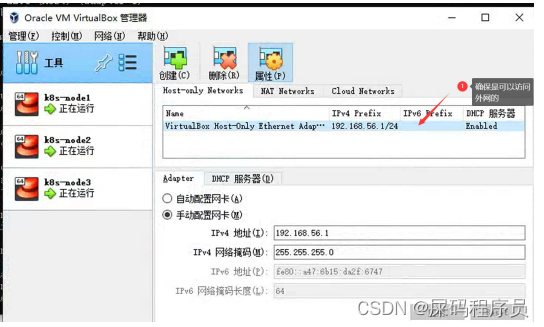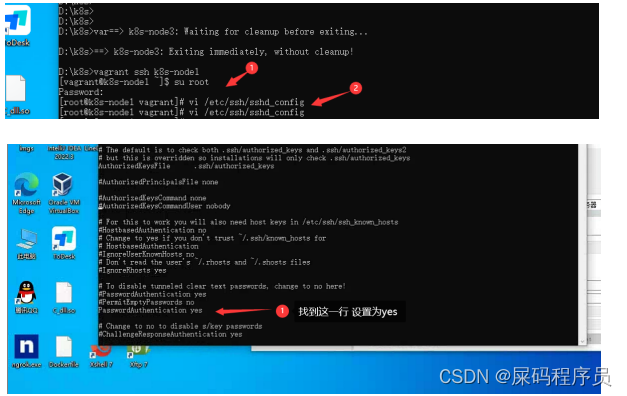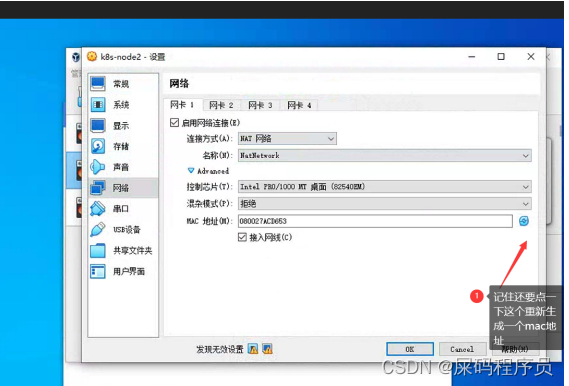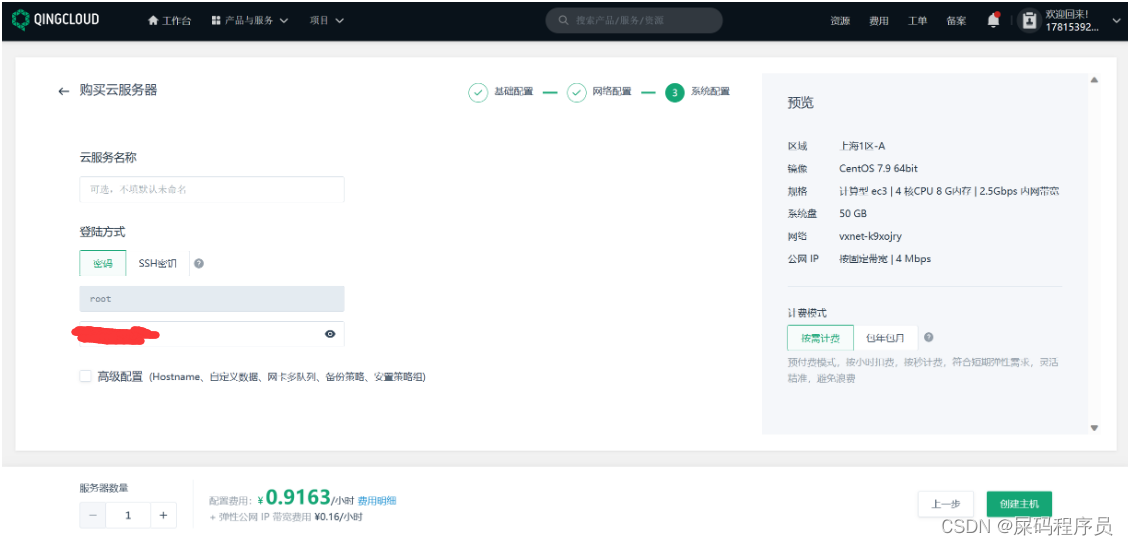k8s:

基础配置(获取三台服务器)
方法一、使用一台Windows电脑创建三台centos虚拟机:
Windows 环境:
- cpu:16个
- 内存:16G
- windows 10
vagrant 组合virtualbox 快速搭建虚拟机:
-
下载最新版vagrant : Vagrant by HashiCorp (vagrantup.com)
-
下载最新版virtualbox:Oracle VM VirtualBox
-
之后进行搭建虚拟机: 由于我先创建好了,才做的笔记 请忽略这三台正在运行的机子
-
检查我们的 virtualbox 的网卡设置

-
之后进行全局设置一下我们的虚拟机的存放的位置:
![[外链图片转存失败,源站可能有防盗链机制,建议将图片保存下来直接上传(img-IYtSAIYG-1685331533243)(C:\Users\ACER\AppData\Roaming\Typora\typora-user-images\image-20230417202233851.png)]](https://img-blog.csdnimg.cn/10772248bf1e4d11af3e1c81d7d345f5.png)
-
来到我们保存vagrant 的文件的位置
![[外链图片转存失败,源站可能有防盗链机制,建议将图片保存下来直接上传(img-ph9CnL8f-1685331533243)(C:\Users\ACER\AppData\Roaming\Typora\typora-user-images\image-20230417202251723.png)]](https://img-blog.csdnimg.cn/14d350a08f4348548f586f1cb463298c.png)
-
打开cmd命令尽心初始化文件
vagrant init centos/7 -
执行完上面的命令后,会在用户的家目录下生成Vagrantfile文件

-
VagrantFile文件:
Vagrant.configure("2") do |config| #遍历3次。生成3个 (1..3).each do |i| config.vm.define "k8s-node#{i}" do |node| # 设置虚拟机的Box。指定本地的box文件 node.vm.box = "centos/7" # 设置虚拟机的主机名 node.vm.hostname="k8s-node#{i}" # 设置虚拟机的IP node.vm.network "private_network", ip: "192.168.56.#{99+i}", netmask: "255.255.255.0" # 设置主机与虚拟机的共享目录 # node.vm.synced_folder "~/Documents/vagrant/share", "/home/vagrant/share" # VirtaulBox相关配置 node.vm.provider "virtualbox" do |v| # 设置虚拟机的名称 v.name = "k8s-node#{i}" # 设置虚拟机的内存大小 v.memory = 4096 # 设置虚拟机的CPU个数 v.cpus = 4 end end end end
-
-
之后就开始操作
-
由于我们要去远程下载centos/7 等待 试讲就会很长 所以我们可以直接先将文件下载下来 去 centos 官网下载 centos镜像(按理说会自动下载的,但是我的找不到)
-
选择vagrant 的
![[外链图片转存失败,源站可能有防盗链机制,建议将图片保存下来直接上传(img-H74Sk8Pv-1685331533244)(C:\Users\ACER\AppData\Roaming\Typora\typora-user-images\image-20230529112804541.png)]](https://img-blog.csdnimg.cn/b09df7abca834b2081a0afe4957c3140.png)
-
下载好后放入同级目录下即可
![[外链图片转存失败,源站可能有防盗链机制,建议将图片保存下来直接上传(img-uqTn0CnD-1685331533244)(C:\Users\ACER\AppData\Roaming\Typora\typora-user-images\image-20230529113420492.png)]](https://img-blog.csdnimg.cn/094a8546724e4776aa4d97066f6c1dca.png)
-
之后将centos/7 添加进 vagrant中
vagrant box add centos/7 D:\developsoft\CentOS-7-x86_64-Vagrant1905_01.VirtualBox.box -
来到安装目录下 (确保启动 virtualbox ) 打开cmd命令框 输入命令
vagrant up -
. 进行虚拟机的创建 :
![[外链图片转存失败,源站可能有防盗链机制,建议将图片保存下来直接上传(img-spgmCPhj-1685331533245)(C:\Users\ACER\AppData\Roaming\Typora\typora-user-images\image-20230417202514010.png)]](https://img-blog.csdnimg.cn/ddce744039094408b7faa6b51d38dfd7.png)
修改访问 设置ssh也可以访问:
使用vagrant 的ssh 进行连接 即可 使用
vagrant ssh 虚拟机名称
![[外链图片转存失败,源站可能有防盗链机制,建议将图片保存下来直接上传(img-KAT6Bjsl-1685331533245)(C:\Users\ACER\AppData\Roaming\Typora\typora-user-images\image-20230417202550087.png)]](https://img-blog.csdnimg.cn/7a67940ca865496b9f69133cff5b4e2b.png)
之后使用指令进行登录
su root
vagrant
之后进入文件 进行修改:
vi /etc/ssh/sshd_config

之后重启虚拟机:
service sshd restart
![[外链图片转存失败,源站可能有防盗链机制,建议将图片保存下来直接上传(img-YG1tS0tP-1685331533246)(C:\Users\ACER\AppData\Roaming\Typora\typora-user-images\image-20230417202711082.png)]](https://img-blog.csdnimg.cn/21b3cac02fa44933af5a344168bcc171.png)
之后其他三台流水线式 设置即可 设置完后 我们就可以使用 XShell 来进行连接了:
配置网络(三台虚拟机的私有网络):
首先将三台虚拟机的电源全部关闭:
-
来到 vir 工具中进行设置网络创建一个net 网络
![[外链图片转存失败,源站可能有防盗链机制,建议将图片保存下来直接上传(img-BEWsfqBr-1685331533246)(C:\Users\ACER\AppData\Roaming\Typora\typora-user-images\image-20230417202810239.png)]](https://img-blog.csdnimg.cn/ea36dc141b2d4b06a4efbb9a620e8632.png)
-
选择net 网络:
![[外链图片转存失败,源站可能有防盗链机制,建议将图片保存下来直接上传(img-ZBicDHRM-1685331533246)(C:\Users\ACER\AppData\Roaming\Typora\typora-user-images\image-20230417202820996.png)]](https://img-blog.csdnimg.cn/b2af6ada075045c0b4e064541ec12bd2.png)
3.
-
之后重启虚拟机 在检查每个虚拟机使用的网路地址是否还是相同,之后就可以进行 ping 一下我们 的网络查看网络是否可以ping的通
-
之后把每个虚拟机的防火墙都给关闭即可
systemctl stop firewalld systemctl disable firewalld
之后查看 我们的三台服务器使用的是那个网卡 因为笔记本电脑都是双网卡模式
ip route show
如果三个服务器的默认网卡地址都为一样的就需要进行修改
不一样就不用了哦
方法二、去qingCloud申请三个服务器:
来到青云 申请三个公网ip:![[外链图片转存失败,源站可能有防盗链机制,建议将图片保存下来直接上传(img-V6onDFWf-1685331533247)(C:\Users\ACER\AppData\Roaming\Typora\typora-user-images\image-20230416082818797.png)]](https://img-blog.csdnimg.cn/aff6da00b6c54123884f6d5aacae712a.png)
创建vpc私有网络:
![[外链图片转存失败,源站可能有防盗链机制,建议将图片保存下来直接上传(img-FG1momUY-1685331533247)(C:\Users\ACER\AppData\Roaming\Typora\typora-user-images\image-20230416083131547.png)]](https://img-blog.csdnimg.cn/49ec40dc76dd4485bba565c42864cc0b.png)
之后就直接创建即可 下面的都默认
创建三台服务器
![[外链图片转存失败,源站可能有防盗链机制,建议将图片保存下来直接上传(img-SOe8tULg-1685331533247)(C:\Users\ACER\AppData\Roaming\Typora\typora-user-images\image-20230416084107671.png)]](https://img-blog.csdnimg.cn/dab0668ac87c41e593629bad50b7c453.png)
![[外链图片转存失败,源站可能有防盗链机制,建议将图片保存下来直接上传(img-eVKhCLSW-1685331533247)(C:\Users\ACER\AppData\Roaming\Typora\typora-user-images\image-20230416084119432.png)]](https://img-blog.csdnimg.cn/f8a09db6ef8d4762bf7215e14f095683.png)
![[外链图片转存失败,源站可能有防盗链机制,建议将图片保存下来直接上传(img-2dGAuiS8-1685331533247)(C:\Users\ACER\AppData\Roaming\Typora\typora-user-images\image-20230416084146249.png)]](https://img-blog.csdnimg.cn/e2520e5b13f0414b8992a410c1d08ef7.png)
![[外链图片转存失败,源站可能有防盗链机制,建议将图片保存下来直接上传(img-lYcugsY6-1685331533248)(C:\Users\ACER\AppData\Roaming\Typora\typora-user-images\image-20230416084320205.png)]](https://img-blog.csdnimg.cn/c01b62d0870e48798f7a729b875ebe87.png)

要创建三台哦 当然两台也行 只是效果不是很好 :
![[外链图片转存失败,源站可能有防盗链机制,建议将图片保存下来直接上传(img-PjGycqqc-1685331533248)(C:\Users\ACER\AppData\Roaming\Typora\typora-user-images\image-20230416085131008.png)]](https://img-blog.csdnimg.cn/735e92068df24832a1f28eb7641bb8c3.png)
之后使用xshell连接上
配置前置环境:
安装docker:
sudo yum remove docker*
sudo yum install -y yum-utils
#配置docker的yum地址
sudo yum-config-manager \
--add-repo \
http://mirrors.aliyun.com/docker-ce/linux/centos/docker-ce.repo
#安装指定版本
sudo yum install -y docker-ce-20.10.7 docker-ce-cli-20.10.7 containerd.io-1.4.6
# 启动&开机启动docker
systemctl enable docker --now
# docker加速配置
sudo mkdir -p /etc/docker
sudo tee /etc/docker/daemon.json <<-'EOF'
{
"registry-mirrors": ["https://82m9ar63.mirror.aliyuncs.com"],
"exec-opts": ["native.cgroupdriver=systemd"],
"log-driver": "json-file",
"log-opts": {
"max-size": "100m"
},
"storage-driver": "overlay2"
}
EOF
sudo systemctl daemon-reload
sudo systemctl restart docker
重新设置 :
为每个机器设置名称 好方便下面操作(三台服务器都要设置):
#设置每个机器自己的hostname
hostnamectl set-hostname xxx
eg:
作为主节点的服务器设置为: hostnamectl set-hostname master
其余两台工作服务器
第一台 :hostnamectl set-hostname node1
第一台 :hostnamectl set-hostname node2
安装基本环境:
# 将 SELinux 设置为 permissive 模式(相当于将其禁用)
sudo setenforce 0
sudo sed -i 's/^SELINUX=enforcing$/SELINUX=permissive/' /etc/selinux/config
#关闭swap
swapoff -a
sed -ri 's/.*swap.*/#&/' /etc/fstab
#允许 iptables 检查桥接流量
cat <<EOF | sudo tee /etc/modules-load.d/k8s.conf
br_netfilter
EOF
cat <<EOF | sudo tee /etc/sysctl.d/k8s.conf
net.bridge.bridge-nf-call-ip6tables = 1
net.bridge.bridge-nf-call-iptables = 1
EOF
sudo sysctl --system
安装kubelet、kubeadm、kubectl
#配置k8s的yum源地址
cat <<EOF | sudo tee /etc/yum.repos.d/kubernetes.repo
[kubernetes]
name=Kubernetes
baseurl=http://mirrors.aliyun.com/kubernetes/yum/repos/kubernetes-el7-x86_64
enabled=1
gpgcheck=0
repo_gpgcheck=0
gpgkey=http://mirrors.aliyun.com/kubernetes/yum/doc/yum-key.gpg
http://mirrors.aliyun.com/kubernetes/yum/doc/rpm-package-key.gpg
EOF
#安装 kubelet,kubeadm,kubectl
sudo yum install -y kubelet-1.20.9 kubeadm-1.20.9 kubectl-1.20.9
#启动kubelet
sudo systemctl enable --now kubelet
#所有机器配置master域名
echo "10.13.111.175 k8s-master" >> /etc/hosts
注意点需要更改的地点为: 更换为 自己master 的主机地址 是vpc虚拟网络的 不是公网ip
#所有机器配置master域名
echo "10.13.111.175 k8s-master" >> /etc/hosts
配置完后就进行ping 一下 看是否都能找到:
ping k8s-master
arm架构的k8s 阿里源:
这个是针对服务器的系统,如果是arm系统的服务器才需要配置这个镜像地址,否者直接跳过者一步。
cat <<EOF | sudo tee /etc/yum.repos.d/kubernetes.repo
[kubernetes]
name=Kubernetes
baseurl=http://mirrors.aliyun.com/kubernetes/yum/repos/kubernetes-el7-aarch64/
enabled=1
gpgcheck=0
repo_gpgcheck=0
gpgkey=http://mirrors.aliyun.com/kubernetes/yum/doc/yum-key.gpg
http://mirrors.aliyun.com/kubernetes/yum/doc/rpm-package-key.gpg
EOF
初始化master 节点:
kubeadm init \
--apiserver-advertise-address=10.13.111.175 \
--control-plane-endpoint=k8s-master \
--image-repository registry.cn-hangzhou.aliyuncs.com/lfy_k8s_images \
--kubernetes-version v1.20.9 \
--service-cidr=10.96.0.0/16 \
--pod-network-cidr=192.168.0.0/16
更改地方为: 还是将地址改为master 的主机地址
--apiserver-advertise-address=10.13.111.175 \
表示撤销初始化master节点(错误或者失败时使用)
sudo kubeadm reset
记录关键信息:
Your Kubernetes control-plane has initialized successfully!
To start using your cluster, you need to run the following as a regular user:
mkdir -p $HOME/.kube
sudo cp -i /etc/kubernetes/admin.conf $HOME/.kube/config
sudo chown $(id -u):$(id -g) $HOME/.kube/config
Alternatively, if you are the root user, you can run:
export KUBECONFIG=/etc/kubernetes/admin.conf
You should now deploy a pod network to the cluster.
Run "kubectl apply -f [podnetwork].yaml" with one of the options listed at:
https://kubernetes.io/docs/concepts/cluster-administration/addons/
You can now join any number of control-plane nodes by copying certificate authorities
and service account keys on each node and then running the following as root:
kubeadm join k8s-master:6443 --token yodfqt.bz8x38s644631ek6 \
--discovery-token-ca-cert-hash sha256:198d4c123c7772ed3956d82fa8d556cd6e8109283441c4a5feaaede7d6440967 \
--control-plane
Then you can join any number of worker nodes by running the following on each as root:
kubeadm join k8s-master:6443 --token yodfqt.bz8x38s644631ek6 \
--discovery-token-ca-cert-hash sha256:198d4c123c7772ed3956d82fa8d556cd6e8109283441c4a5feaaede7d6440967
之后再master节点上执行: 也就是关键信息中的
mkdir -p $HOME/.kube
sudo cp -i /etc/kubernetes/admin.conf $HOME/.kube/config
sudo chown $(id -u):$(id -g) $HOME/.kube/config
安装网络插件:
curl https://docs.projectcalico.org/v3.20/manifests/calico.yaml -O
kubectl apply -f calico.yaml
加入worker 节点:
在子节点 也就是node1和node2中执行 这个命令是关键信息中的
kubeadm join k8s-master:6443 --token yodfqt.bz8x38s644631ek6 \
--discovery-token-ca-cert-hash sha256:198d4c123c7772ed3956d82fa8d556cd6e8109283441c4a5feaaede7d6440967
nfs文件系统
# 在每个机器。
yum install -y nfs-utils
之后再master节点:
# 在master 执行以下命令
echo "/nfs/data/ *(insecure,rw,sync,no_root_squash)" > /etc/exports
# 执行以下命令,启动 nfs 服务;创建共享目录
mkdir -p /nfs/data
# 在master执行
systemctl enable rpcbind
systemctl enable nfs-server
systemctl start rpcbind
systemctl start nfs-server
# 使配置生效
exportfs -r
#检查配置是否生效
exportfs
在子节点 也就是node1和node2节点进行 :
showmount -e 10.0.2.15
mkdir -p /nfs/data
mount -t nfs 10.0.2.15:/nfs/data /nfs/data
注意点: 修改地址:改为 master节点的地址
配置默认存储:
在master节点上
vi sc.yaml
粘贴以下内容
## 创建了一个存储类
apiVersion: storage.k8s.io/v1
kind: StorageClass
metadata:
name: nfs-storage
annotations:
storageclass.kubernetes.io/is-default-class: "true"
provisioner: k8s-sigs.io/nfs-subdir-external-provisioner
parameters:
archiveOnDelete: "true" ## 删除pv的时候,pv的内容是否要备份
---
apiVersion: apps/v1
kind: Deployment
metadata:
name: nfs-client-provisioner
labels:
app: nfs-client-provisioner
# replace with namespace where provisioner is deployed
namespace: default
spec:
replicas: 1
strategy:
type: Recreate
selector:
matchLabels:
app: nfs-client-provisioner
template:
metadata:
labels:
app: nfs-client-provisioner
spec:
serviceAccountName: nfs-client-provisioner
containers:
- name: nfs-client-provisioner
image: registry.cn-hangzhou.aliyuncs.com/lfy_k8s_images/nfs-subdir-external-provisioner:v4.0.2
# resources:
# limits:
# cpu: 10m
# requests:
# cpu: 10m
volumeMounts:
- name: nfs-client-root
mountPath: /persistentvolumes
env:
- name: PROVISIONER_NAME
value: k8s-sigs.io/nfs-subdir-external-provisioner
- name: NFS_SERVER
value: 10.0.2.15 ## 指定自己nfs服务器地址
- name: NFS_PATH
value: /nfs/data ## nfs服务器共享的目录
volumes:
- name: nfs-client-root
nfs:
server: 10.0.2.15
path: /nfs/data
---
apiVersion: v1
kind: ServiceAccount
metadata:
name: nfs-client-provisioner
# replace with namespace where provisioner is deployed
namespace: default
---
kind: ClusterRole
apiVersion: rbac.authorization.k8s.io/v1
metadata:
name: nfs-client-provisioner-runner
rules:
- apiGroups: [""]
resources: ["nodes"]
verbs: ["get", "list", "watch"]
- apiGroups: [""]
resources: ["persistentvolumes"]
verbs: ["get", "list", "watch", "create", "delete"]
- apiGroups: [""]
resources: ["persistentvolumeclaims"]
verbs: ["get", "list", "watch", "update"]
- apiGroups: ["storage.k8s.io"]
resources: ["storageclasses"]
verbs: ["get", "list", "watch"]
- apiGroups: [""]
resources: ["events"]
verbs: ["create", "update", "patch"]
---
kind: ClusterRoleBinding
apiVersion: rbac.authorization.k8s.io/v1
metadata:
name: run-nfs-client-provisioner
subjects:
- kind: ServiceAccount
name: nfs-client-provisioner
# replace with namespace where provisioner is deployed
namespace: default
roleRef:
kind: ClusterRole
name: nfs-client-provisioner-runner
apiGroup: rbac.authorization.k8s.io
---
kind: Role
apiVersion: rbac.authorization.k8s.io/v1
metadata:
name: leader-locking-nfs-client-provisioner
# replace with namespace where provisioner is deployed
namespace: default
rules:
- apiGroups: [""]
resources: ["endpoints"]
verbs: ["get", "list", "watch", "create", "update", "patch"]
---
kind: RoleBinding
apiVersion: rbac.authorization.k8s.io/v1
metadata:
name: leader-locking-nfs-client-provisioner
# replace with namespace where provisioner is deployed
namespace: default
subjects:
- kind: ServiceAccount
name: nfs-client-provisioner
# replace with namespace where provisioner is deployed
namespace: default
roleRef:
kind: Role
name: leader-locking-nfs-client-provisioner
apiGroup: rbac.authorization.k8s.io
应用:
kubectl apply -f sc.yaml
#查看
kubectl get sc
安装 metrics-server:
vi metrics.yaml
粘贴:
apiVersion: v1
kind: ServiceAccount
metadata:
labels:
k8s-app: metrics-server
name: metrics-server
namespace: kube-system
---
apiVersion: rbac.authorization.k8s.io/v1
kind: ClusterRole
metadata:
labels:
k8s-app: metrics-server
rbac.authorization.k8s.io/aggregate-to-admin: "true"
rbac.authorization.k8s.io/aggregate-to-edit: "true"
rbac.authorization.k8s.io/aggregate-to-view: "true"
name: system:aggregated-metrics-reader
rules:
- apiGroups:
- metrics.k8s.io
resources:
- pods
- nodes
verbs:
- get
- list
- watch
---
apiVersion: rbac.authorization.k8s.io/v1
kind: ClusterRole
metadata:
labels:
k8s-app: metrics-server
name: system:metrics-server
rules:
- apiGroups:
- ""
resources:
- pods
- nodes
- nodes/stats
- namespaces
- configmaps
verbs:
- get
- list
- watch
---
apiVersion: rbac.authorization.k8s.io/v1
kind: RoleBinding
metadata:
labels:
k8s-app: metrics-server
name: metrics-server-auth-reader
namespace: kube-system
roleRef:
apiGroup: rbac.authorization.k8s.io
kind: Role
name: extension-apiserver-authentication-reader
subjects:
- kind: ServiceAccount
name: metrics-server
namespace: kube-system
---
apiVersion: rbac.authorization.k8s.io/v1
kind: ClusterRoleBinding
metadata:
labels:
k8s-app: metrics-server
name: metrics-server:system:auth-delegator
roleRef:
apiGroup: rbac.authorization.k8s.io
kind: ClusterRole
name: system:auth-delegator
subjects:
- kind: ServiceAccount
name: metrics-server
namespace: kube-system
---
apiVersion: rbac.authorization.k8s.io/v1
kind: ClusterRoleBinding
metadata:
labels:
k8s-app: metrics-server
name: system:metrics-server
roleRef:
apiGroup: rbac.authorization.k8s.io
kind: ClusterRole
name: system:metrics-server
subjects:
- kind: ServiceAccount
name: metrics-server
namespace: kube-system
---
apiVersion: v1
kind: Service
metadata:
labels:
k8s-app: metrics-server
name: metrics-server
namespace: kube-system
spec:
ports:
- name: https
port: 443
protocol: TCP
targetPort: https
selector:
k8s-app: metrics-server
---
apiVersion: apps/v1
kind: Deployment
metadata:
labels:
k8s-app: metrics-server
name: metrics-server
namespace: kube-system
spec:
selector:
matchLabels:
k8s-app: metrics-server
strategy:
rollingUpdate:
maxUnavailable: 0
template:
metadata:
labels:
k8s-app: metrics-server
spec:
containers:
- args:
- --cert-dir=/tmp
- --kubelet-insecure-tls
- --secure-port=4443
- --kubelet-preferred-address-types=InternalIP,ExternalIP,Hostname
- --kubelet-use-node-status-port
image: registry.cn-hangzhou.aliyuncs.com/lfy_k8s_images/metrics-server:v0.4.3
imagePullPolicy: IfNotPresent
livenessProbe:
failureThreshold: 3
httpGet:
path: /livez
port: https
scheme: HTTPS
periodSeconds: 10
name: metrics-server
ports:
- containerPort: 4443
name: https
protocol: TCP
readinessProbe:
failureThreshold: 3
httpGet:
path: /readyz
port: https
scheme: HTTPS
periodSeconds: 10
securityContext:
readOnlyRootFilesystem: true
runAsNonRoot: true
runAsUser: 1000
volumeMounts:
- mountPath: /tmp
name: tmp-dir
nodeSelector:
kubernetes.io/os: linux
priorityClassName: system-cluster-critical
serviceAccountName: metrics-server
volumes:
- emptyDir: {
}
name: tmp-dir
---
apiVersion: apiregistration.k8s.io/v1
kind: APIService
metadata:
labels:
k8s-app: metrics-server
name: v1beta1.metrics.k8s.io
spec:
group: metrics.k8s.io
groupPriorityMinimum: 100
insecureSkipTLSVerify: true
service:
name: metrics-server
namespace: kube-system
version: v1beta1
versionPriority: 100
应用:
kubectl apply -f metrics.yaml
查看测试:
kubectl top nodes
![[外链图片转存失败,源站可能有防盗链机制,建议将图片保存下来直接上传(img-VUXReHdK-1685331533249)(C:\Users\ACER\AppData\Roaming\Typora\typora-user-images\image-20230416102833435.png)]](https://img-blog.csdnimg.cn/7c3d25e0867f4c5f9fe7591c8cc21b00.png)
安装metrics-server后,pod启动时成功的就是一直报这个错。网上找了很多放法,不管用,可以试试。
![[外链图片转存失败,源站可能有防盗链机制,建议将图片保存下来直接上传(img-1yvxeQVY-1685331533249)(C:\Users\ACER\AppData\Roaming\Typora\typora-user-images\image-20230417212443151.png)]](https://img-blog.csdnimg.cn/ee14ff9a5fa145989e93ed0961d9161e.png)
解决方法:新增hostNetwork: true到metries-server.yaml:
参考地址:kubernetes - Error from server (ServiceUnavailable): the server is currently unable to handle the request (get nodes.metrics.k8s.io) - Stack Overflow
apiVersion: apps/v1
kind: Deployment
metadata:
labels:
k8s-app: metrics-server
name: metrics-server
namespace: kube-system
spec:
selector:
matchLabels:
k8s-app: metrics-server
strategy:
rollingUpdate:
maxUnavailable: 0
template:
metadata:
labels:
k8s-app: metrics-server
spec:
hostNetwork: true ## 新增
安装KubeSphere
https://kubesphere.com.cn/
1、下载核心文件
如果下载不到,请复制附录的内容
wget https://github.com/kubesphere/ks-installer/releases/download/v3.1.1/kubesphere-installer.yaml
wget https://github.com/kubesphere/ks-installer/releases/download/v3.1.1/cluster-configuration.yaml
2、修改cluster-configuration (重要)
也就是将cluster-configuration.yaml 文件中的所有false 改为true (除了 metrics-server )还有ip地址 改为master,指定网络
具体可以参照附录中的文件进行:
执行安装:
kubectl apply -f kubesphere-installer.yaml
kubectl apply -f cluster-configuration.yaml
查看进度:
kubectl logs -n kubesphere-system $(kubectl get pod -n kubesphere-system -l app=ks-install -o jsonpath='{
.items[0].metadata.name}') -f
如果是青云记得开放端口:![[外链图片转存失败,源站可能有防盗链机制,建议将图片保存下来直接上传(img-HGmZeADq-1685331533249)(C:\Users\ACER\AppData\Roaming\Typora\typora-user-images\image-20230416105136757.png)]](https://img-blog.csdnimg.cn/315484ca58714e7f94e49bc377aa1b24.png)
访问任意机器的 30880端口
账号 : admin
密码 : P@88w0rd
解决etcd监控证书找不到问题
根据情况来执行:否则适得其反
kubectl -n kubesphere-monitoring-system create secret generic kube-etcd-client-certs --from-file=etcd-client-ca.crt=/etc/kubernetes/pki/etcd/ca.crt --from-file=etcd-client.crt=/etc/kubernetes/pki/apiserver-etcd-client.crt --from-file=etcd-client.key=/etc/kubernetes/pki/apiserver-etcd-client.key
安装完成效果:
![[外链图片转存失败,源站可能有防盗链机制,建议将图片保存下来直接上传(img-E4iNMLMI-1685331533249)(C:\Users\ACER\AppData\Roaming\Typora\typora-user-images\image-20230416110138529.png)]](https://img-blog.csdnimg.cn/531a003302cd44c1851e0d3153d2c07d.png)
附录:
kubesphere-installer.yaml
---
apiVersion: apiextensions.k8s.io/v1beta1
kind: CustomResourceDefinition
metadata:
name: clusterconfigurations.installer.kubesphere.io
spec:
group: installer.kubesphere.io
versions:
- name: v1alpha1
served: true
storage: true
scope: Namespaced
names:
plural: clusterconfigurations
singular: clusterconfiguration
kind: ClusterConfiguration
shortNames:
- cc
---
apiVersion: v1
kind: Namespace
metadata:
name: kubesphere-system
---
apiVersion: v1
kind: ServiceAccount
metadata:
name: ks-installer
namespace: kubesphere-system
---
apiVersion: rbac.authorization.k8s.io/v1
kind: ClusterRole
metadata:
name: ks-installer
rules:
- apiGroups:
- ""
resources:
- '*'
verbs:
- '*'
- apiGroups:
- apps
resources:
- '*'
verbs:
- '*'
- apiGroups:
- extensions
resources:
- '*'
verbs:
- '*'
- apiGroups:
- batch
resources:
- '*'
verbs:
- '*'
- apiGroups:
- rbac.authorization.k8s.io
resources:
- '*'
verbs:
- '*'
- apiGroups:
- apiregistration.k8s.io
resources:
- '*'
verbs:
- '*'
- apiGroups:
- apiextensions.k8s.io
resources:
- '*'
verbs:
- '*'
- apiGroups:
- tenant.kubesphere.io
resources:
- '*'
verbs:
- '*'
- apiGroups:
- certificates.k8s.io
resources:
- '*'
verbs:
- '*'
- apiGroups:
- devops.kubesphere.io
resources:
- '*'
verbs:
- '*'
- apiGroups:
- monitoring.coreos.com
resources:
- '*'
verbs:
- '*'
- apiGroups:
- logging.kubesphere.io
resources:
- '*'
verbs:
- '*'
- apiGroups:
- jaegertracing.io
resources:
- '*'
verbs:
- '*'
- apiGroups:
- storage.k8s.io
resources:
- '*'
verbs:
- '*'
- apiGroups:
- admissionregistration.k8s.io
resources:
- '*'
verbs:
- '*'
- apiGroups:
- policy
resources:
- '*'
verbs:
- '*'
- apiGroups:
- autoscaling
resources:
- '*'
verbs:
- '*'
- apiGroups:
- networking.istio.io
resources:
- '*'
verbs:
- '*'
- apiGroups:
- config.istio.io
resources:
- '*'
verbs:
- '*'
- apiGroups:
- iam.kubesphere.io
resources:
- '*'
verbs:
- '*'
- apiGroups:
- notification.kubesphere.io
resources:
- '*'
verbs:
- '*'
- apiGroups:
- auditing.kubesphere.io
resources:
- '*'
verbs:
- '*'
- apiGroups:
- events.kubesphere.io
resources:
- '*'
verbs:
- '*'
- apiGroups:
- core.kubefed.io
resources:
- '*'
verbs:
- '*'
- apiGroups:
- installer.kubesphere.io
resources:
- '*'
verbs:
- '*'
- apiGroups:
- storage.kubesphere.io
resources:
- '*'
verbs:
- '*'
- apiGroups:
- security.istio.io
resources:
- '*'
verbs:
- '*'
- apiGroups:
- monitoring.kiali.io
resources:
- '*'
verbs:
- '*'
- apiGroups:
- kiali.io
resources:
- '*'
verbs:
- '*'
- apiGroups:
- networking.k8s.io
resources:
- '*'
verbs:
- '*'
- apiGroups:
- kubeedge.kubesphere.io
resources:
- '*'
verbs:
- '*'
- apiGroups:
- types.kubefed.io
resources:
- '*'
verbs:
- '*'
---
kind: ClusterRoleBinding
apiVersion: rbac.authorization.k8s.io/v1
metadata:
name: ks-installer
subjects:
- kind: ServiceAccount
name: ks-installer
namespace: kubesphere-system
roleRef:
kind: ClusterRole
name: ks-installer
apiGroup: rbac.authorization.k8s.io
---
apiVersion: apps/v1
kind: Deployment
metadata:
name: ks-installer
namespace: kubesphere-system
labels:
app: ks-install
spec:
replicas: 1
selector:
matchLabels:
app: ks-install
template:
metadata:
labels:
app: ks-install
spec:
serviceAccountName: ks-installer
containers:
- name: installer
image: kubesphere/ks-installer:v3.1.1
imagePullPolicy: "Always"
resources:
limits:
cpu: "1"
memory: 1Gi
requests:
cpu: 20m
memory: 100Mi
volumeMounts:
- mountPath: /etc/localtime
name: host-time
volumes:
- hostPath:
path: /etc/localtime
type: ""
name: host-time
cluster-configuration.yaml
---
apiVersion: installer.kubesphere.io/v1alpha1
kind: ClusterConfiguration
metadata:
name: ks-installer
namespace: kubesphere-system
labels:
version: v3.1.1
spec:
persistence:
storageClass: "" # If there is no default StorageClass in your cluster, you need to specify an existing StorageClass here.
authentication:
jwtSecret: "" # Keep the jwtSecret consistent with the Host Cluster. Retrieve the jwtSecret by executing "kubectl -n kubesphere-system get cm kubesphere-config -o yaml | grep -v "apiVersion" | grep jwtSecret" on the Host Cluster.
local_registry: "" # Add your private registry address if it is needed.
etcd:
monitoring: true # Enable or disable etcd monitoring dashboard installation. You have to create a Secret for etcd before you enable it.
endpointIps: 172.31.0.4 # etcd cluster EndpointIps. It can be a bunch of IPs here.
port: 2379 # etcd port.
tlsEnable: true
common:
redis:
enabled: true
openldap:
enabled: true
minioVolumeSize: 20Gi # Minio PVC size.
openldapVolumeSize: 2Gi # openldap PVC size.
redisVolumSize: 2Gi # Redis PVC size.
monitoring:
# type: external # Whether to specify the external prometheus stack, and need to modify the endpoint at the next line.
endpoint: http://prometheus-operated.kubesphere-monitoring-system.svc:9090 # Prometheus endpoint to get metrics data.
es: # Storage backend for logging, events and auditing.
# elasticsearchMasterReplicas: 1 # The total number of master nodes. Even numbers are not allowed.
# elasticsearchDataReplicas: 1 # The total number of data nodes.
elasticsearchMasterVolumeSize: 4Gi # The volume size of Elasticsearch master nodes.
elasticsearchDataVolumeSize: 20Gi # The volume size of Elasticsearch data nodes.
logMaxAge: 7 # Log retention time in built-in Elasticsearch. It is 7 days by default.
elkPrefix: logstash # The string making up index names. The index name will be formatted as ks-<elk_prefix>-log.
basicAuth:
enabled: false
username: ""
password: ""
externalElasticsearchUrl: ""
externalElasticsearchPort: ""
console:
enableMultiLogin: true # Enable or disable simultaneous logins. It allows different users to log in with the same account at the same time.
port: 30880
alerting: # (CPU: 0.1 Core, Memory: 100 MiB) It enables users to customize alerting policies to send messages to receivers in time with different time intervals and alerting levels to choose from.
enabled: true # Enable or disable the KubeSphere Alerting System.
# thanosruler:
# replicas: 1
# resources: {
}
auditing: # Provide a security-relevant chronological set of records,recording the sequence of activities happening on the platform, initiated by different tenants.
enabled: true # Enable or disable the KubeSphere Auditing Log System.
devops: # (CPU: 0.47 Core, Memory: 8.6 G) Provide an out-of-the-box CI/CD system based on Jenkins, and automated workflow tools including Source-to-Image & Binary-to-Image.
enabled: true # Enable or disable the KubeSphere DevOps System.
jenkinsMemoryLim: 2Gi # Jenkins memory limit.
jenkinsMemoryReq: 1500Mi # Jenkins memory request.
jenkinsVolumeSize: 8Gi # Jenkins volume size.
jenkinsJavaOpts_Xms: 512m # The following three fields are JVM parameters.
jenkinsJavaOpts_Xmx: 512m
jenkinsJavaOpts_MaxRAM: 2g
events: # Provide a graphical web console for Kubernetes Events exporting, filtering and alerting in multi-tenant Kubernetes clusters.
enabled: true # Enable or disable the KubeSphere Events System.
ruler:
enabled: true
replicas: 2
logging: # (CPU: 57 m, Memory: 2.76 G) Flexible logging functions are provided for log query, collection and management in a unified console. Additional log collectors can be added, such as Elasticsearch, Kafka and Fluentd.
enabled: true # Enable or disable the KubeSphere Logging System.
logsidecar:
enabled: true
replicas: 2
metrics_server: # (CPU: 56 m, Memory: 44.35 MiB) It enables HPA (Horizontal Pod Autoscaler).
enabled: false # Enable or disable metrics-server.
monitoring:
storageClass: "" # If there is an independent StorageClass you need for Prometheus, you can specify it here. The default StorageClass is used by default.
# prometheusReplicas: 1 # Prometheus replicas are responsible for monitoring different segments of data source and providing high availability.
prometheusMemoryRequest: 400Mi # Prometheus request memory.
prometheusVolumeSize: 20Gi # Prometheus PVC size.
# alertmanagerReplicas: 1 # AlertManager Replicas.
multicluster:
clusterRole: none # host | member | none # You can install a solo cluster, or specify it as the Host or Member Cluster.
network:
networkpolicy: # Network policies allow network isolation within the same cluster, which means firewalls can be set up between certain instances (Pods).
# Make sure that the CNI network plugin used by the cluster supports NetworkPolicy. There are a number of CNI network plugins that support NetworkPolicy, including Calico, Cilium, Kube-router, Romana and Weave Net.
enabled: true # Enable or disable network policies.
ippool: # Use Pod IP Pools to manage the Pod network address space. Pods to be created can be assigned IP addresses from a Pod IP Pool.
type: calico # Specify "calico" for this field if Calico is used as your CNI plugin. "none" means that Pod IP Pools are disabled.
topology: # Use Service Topology to view Service-to-Service communication based on Weave Scope.
type: none # Specify "weave-scope" for this field to enable Service Topology. "none" means that Service Topology is disabled.
openpitrix: # An App Store that is accessible to all platform tenants. You can use it to manage apps across their entire lifecycle.
store:
enabled: true # Enable or disable the KubeSphere App Store.
servicemesh: # (0.3 Core, 300 MiB) Provide fine-grained traffic management, observability and tracing, and visualized traffic topology.
enabled: true # Base component (pilot). Enable or disable KubeSphere Service Mesh (Istio-based).
kubeedge: # Add edge nodes to your cluster and deploy workloads on edge nodes.
enabled: true # Enable or disable KubeEdge.
cloudCore:
nodeSelector: {
"node-role.kubernetes.io/worker": ""}
tolerations: []
cloudhubPort: "10000"
cloudhubQuicPort: "10001"
cloudhubHttpsPort: "10002"
cloudstreamPort: "10003"
tunnelPort: "10004"
cloudHub:
advertiseAddress: # At least a public IP address or an IP address which can be accessed by edge nodes must be provided.
- "" # Note that once KubeEdge is enabled, CloudCore will malfunction if the address is not provided.
nodeLimit: "100"
service:
cloudhubNodePort: "30000"
cloudhubQuicNodePort: "30001"
cloudhubHttpsNodePort: "30002"
cloudstreamNodePort: "30003"
tunnelNodePort: "30004"
edgeWatcher:
nodeSelector: {
"node-role.kubernetes.io/worker": ""}
tolerations: []
edgeWatcherAgent:
nodeSelector: {
"node-role.kubernetes.io/worker": ""}
tolerations: []